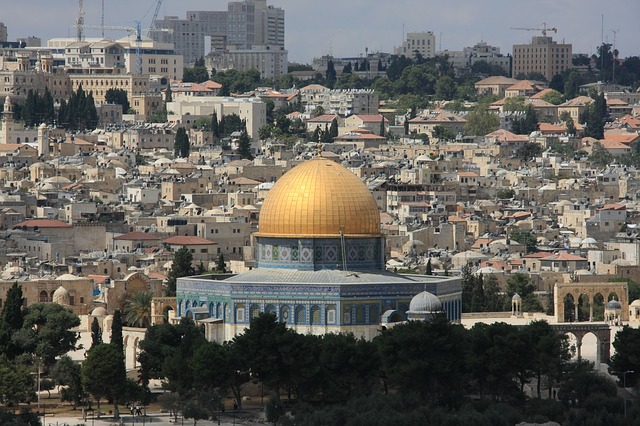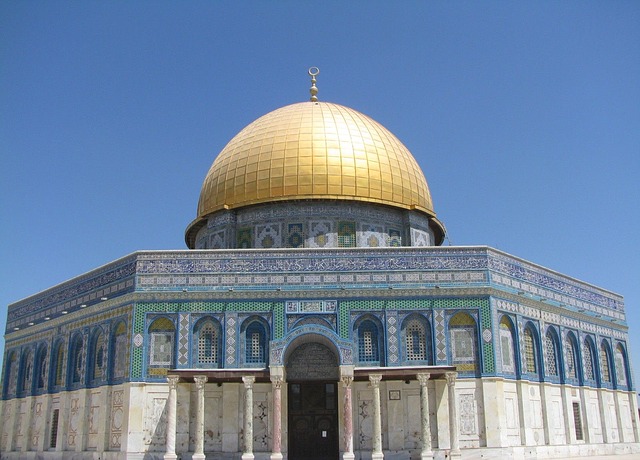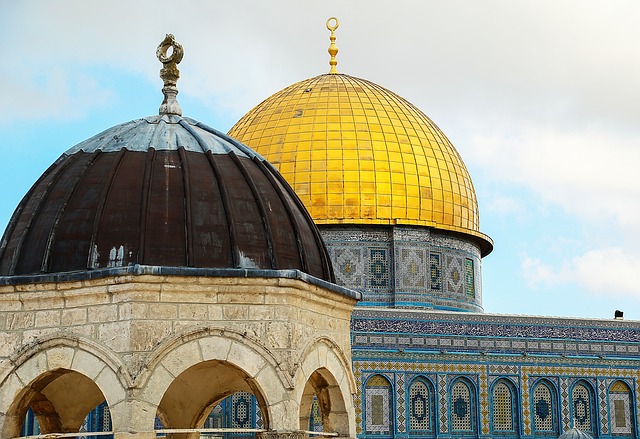Dome of the Rock
Contents |
[edit] Introduction
The Dome of the Rock is an Islamic shrine located on the Temple Mount in the Old City of Jerusalem. It is considered to be one of the oldest and finest examples of Byzantine and emerging Islamic architecture.
The shrine was built over a rock considered sacred by both Muslims and Jews. The Prophet Muhammad is believed to have ascended into heaven from the site, while in Jewish tradition, Abraham is believed to have prepared to sacrifice his son Isaac on the site.
An inscription establishes the date of completion of the Dome of the Rock as 691-692, having been built by the order of Umayyad Caliph Abd al-Malik on the site of Herod’s Temple which was destroyed during the Roman Siege of Jerusalem in 70 CE.
The Byzantine Christian model of churches and martyriums was followed for the overall form of the architectural dome, as well as the decorative mosaics. This is combined with Quranic inscriptions that adorn the building, promoting the virtues of Islam over Christianity.
[edit] Design and construction
The building is dominated by its large, wooden-gilt dome, approximately 20 m in diameter, and rising to a height of 30 m above the surrounding stone-paved platform. The dome’s shape symbolises the soaring ascent to heaven, and its circle represents the wholeness and balance that is essential to the Muslim faith.
The platform is supported by a circular arcade of four piers and twelve columns. An octagonal arcade surrounds this circle, comprising eight piers and sixteen columns, which help support the dome. The octagon is repeated in the outer wall, each of the eight sides measuring 18 m in width and 8 m in height.
The colour of the shrine is also symbolic. Sky blue suggests infinity, while gold represents the colour of the knowledge of Allah.
The interior decorations are extensive and elaborate. There are 1,280 sq. m of intricate mosaics covering the walls from a variety of periods, as well as painted timber, marble, multi-coloured tiles, carpets and carved stone. The mosaics use intricate patterns and geometric shapes in place of figurative art.
The walls enclose a portion of the sacred rock which is exposed and protected by a railing, while a stairway leads to a natural cave beneath the surface.
[edit] Post-construction
The Dome of the Rock has been modified several times since it was completed in the 7th century, with each new group that conquered Jerusalem laying claim to the structure in its own way. In 1016, the original dome collapsed and was rebuilt in 1021.
In the 16th century, the Ottoman sultan Suleyman the Magnificent replaced the exterior mosaics with 45,000 blue and gold ceramic tiles.
In 1994, Jordan and Saudi Arabia donated 80 kg of gold to serve as a new covering for the iconic dome.
[edit] Related articles on Designing Buildings Wiki
IHBC NewsBlog
Old Sarum fire in listed (& disputed) WW1 Hangar - Wiltshire Council has sought legal advice after fire engulfed a listed First World War hangar that was embroiled in a lengthy planning dispute.
UK Antarctic Heritage Trust launches ‘Virtual Visit’ website area
The Trust calls on people to 'Immerse yourself in our heritage – Making Antarctica Accessible'
Southend Council pledge to force Kursaal owners to maintain building
The Council has pledged to use ‘every tool in the toolbox’ if urgent repairs are not carried out.
HE’s Research Magazine publishes a major study of the heritage of England’s suburbs
The article traces the long evolution of an internal programme to research 200 years of suburban growth
IHBC Context 183 Wellbeing and Heritage published
The issue explores issues at the intersection of heritage and wellbeing.
SAVE celebrates 50 years of campaigning 1975-2025
SAVE Britain’s Heritage has announced events across the country to celebrate bringing new life to remarkable buildings.
IHBC Annual School 2025 - Shrewsbury 12-14 June
Themed Heritage in Context – Value: Plan: Change, join in-person or online.
200th Anniversary Celebration of the Modern Railway Planned
The Stockton & Darlington Railway opened on September 27, 1825.
Competence Framework Launched for Sustainability in the Built Environment
The Construction Industry Council (CIC) and the Edge have jointly published the framework.
Historic England Launches Wellbeing Strategy for Heritage
Whether through visiting, volunteering, learning or creative practice, engaging with heritage can strengthen confidence, resilience, hope and social connections.
















